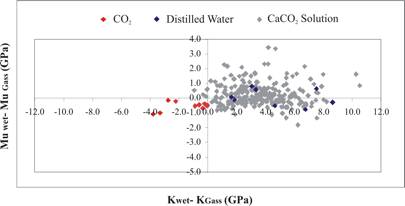

46350-AC8
Experimental Investigation of the Effect of Pressure and Fluid Saturation on Carbonate Rocks
In this project, a comprehensive
laboratory study on carbonate rocks was undertaken to understand how properties
such as mineralogy, pore shape, porosity, and fluid type control seismic wave
propagation. The velocity-porosity plot
(Figure 1) confirms a strong dependence of P- and S-wave velocities on
porosity. Samples dominated by calcite (FP and GR, respectively) follow a
fairly smooth and continuous trend over a porosity range from 2% to 52%; those
with mixed calcite-dolomite composition (MSA) show a slightly flatter trend
over the range of porosity from 2% to 12%. In contrast, MA samples depart significantly from
the main trend, which seems to correlate with the increase of micrite and
sparite interstitial sediments. Another
key question in rock physics studies is how seismic velocities (elastic moduli)
vary with pore fluid content.
This is critical for remote seismic detection of hydrocarbons and
monitoring reservoir changes associated with water injection, hydrocarbon
production, as well as the movement and trapping of sequestered CO2. To address this problem, measurements
were made on initially dry samples and again on samples saturated with various
aqueous solutions. Most of
core plugs were saturated with water, saturated with CaCO3 in order
to minimize dissolution in calcite-rich samples. Some samples were saturated
with degassed, distilled water and others with a slightly acidic, aqueous
solution of carbonated water. The
observed changes in velocities between dry and saturated conditions were
compared with predictions of the Gassmann fluid-substitution equations, which
predict that the rock effective elastic shear moduli should be independent of
saturation while the bulk modulus will vary with the bulk modulus of the pore
fluid. After
saturation, samples were allowed to dry in order to measure whether any change
in porosity and permeability had occurred. Samples saturated with CaCO3
aqueous solution and samples saturated with degassed, distilled water mostly
show negligible change in porosity and permeability. In contrast, samples saturated with carbonated water show a
greater variation in both porosity (up to 5%) and permeability (up to 400mD). These
results indicate that seismic fluid substitution in carbonates is likely to be
more than a purely mechanical problem. The presence in reservoirs of fluids and
lithologies that are susceptible to chemical reactions poses new challenges
when modeling the effect of pore fluids on geophysical observations. These
challenges arise because physical and chemical processes have traditionally
been treated as decoupled problems. As a consequence, purely mechanical models
of fluid substitution are not appropriate for quantifying the effects on
in-situ seismic velocities when chemical processes are triggered. Chemical effects such as mineralogical
changes, dissolution, and precipitation induce changes in the properties of the
rock frame, which alter the baseline of Gassmann's equations. Figure 1: P-wave and S-wave velocities versus porosity for dry (open
diamonds) and saturated (filled diamonds) carbonate samples. Data are
color-coded by formation: Blue – MSA, Green – FP, Yellow –
MA, and Red – GR.
Figure 2:
Difference of measured shear moduli (Mu-wet) and predicted shear moduli
(Mu-Gass) versus the corresponding difference bulk moduli. Data correspond to
core plugs saturated with degassed, distilled water (blue diamonds), CaCO3
aqueous solution (gray diamonds), and carbonated water (red diamonds).

